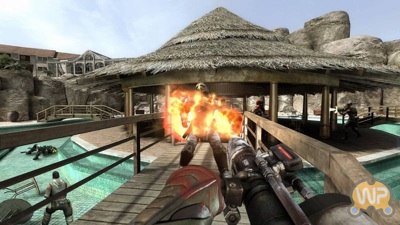The Near-Death Experience of Dying in a Game
Clive Thompson, one of the keenest techno-culture observers around, has posted a particularly insightful riff on recent news that many game players get more of rush when others kill them, than when they kill others. It’s worth quoting at length.

Apparently the act of killing other people causes enormous strain on us; however, we actually enjoy getting shot to death. As Brandon Erickson summarizes it:
“… instead of joy resulting from victory and success, wounding and killing the opponent elicited anxiety, anger, or both.” In addition, “death of the player’s own character…appear[s] to increase some aspects of positive emotion.” This latter finding the authors believe may result from the temporary “relief from engagement” brought about by character death.
That latter argument makes sense to me. When I’m in a really intense firefight in a game, I’m a total wreck, emotionally. Sure, it feels good to vanquish my foes, but sometimes it’s just nice to get a break, and dying is — among, uh, other things — certainly a break.
Part of this has to do with the intriguing aesthetic question of precisely how the first-person-shooter represents the player after the moment of death. Multiplayer Halo online offers my personal favorite death vignettes. The instant you die, the game shifts to a third-person camera perspective and follows your body as it slumps to the ground or, more often, goes pinwheeling through the air.
This sudden switch in camera angle — from first person to third person — is, in essence, a classic out-of-body experience, of exactly the sort people describe in near-death experiences. And much like real-life near-death experiences, it tends to suffuse me with a curiously zen-like feeling.
In the classic real-life near death experience, the dying person sees everything from a newly disembodied position that floats over their dead body, in a sort of all-seeing third-person viewpoint. Only in death, this new soul-view feels like the prime view, and their dying body is totally outside them. Clive continues:
The emotional narrative goes like this: During the gameplay, I’ll be desperately fighting for my life, ducking behind pillars, firing spastically, and synaesthetically wincing each time I take gunfire. Just when I think I’m safe, I’ll turn a corner, and whoa — find myself face-to-face with another opponent who slams me with a surprise punch, killing me instantly. The final attack will give me one final jolt of amygladaic shock, and then …… hey, I’m dead, and my body is floating through the air, and I’m watching myself just sort of tumble around lazily, like a ragdoll. It’s amazingly peaceful.
The peace attained in near-death experiences is commonly reported. It will be very interesting to see what kinds of conventions emerge for depicting those transitional moments, and whether they elicit a universal reaction. Games are seen as ways to practice, play and rehearse all kinds of things. Maybe we can use games to practice dying as well?


